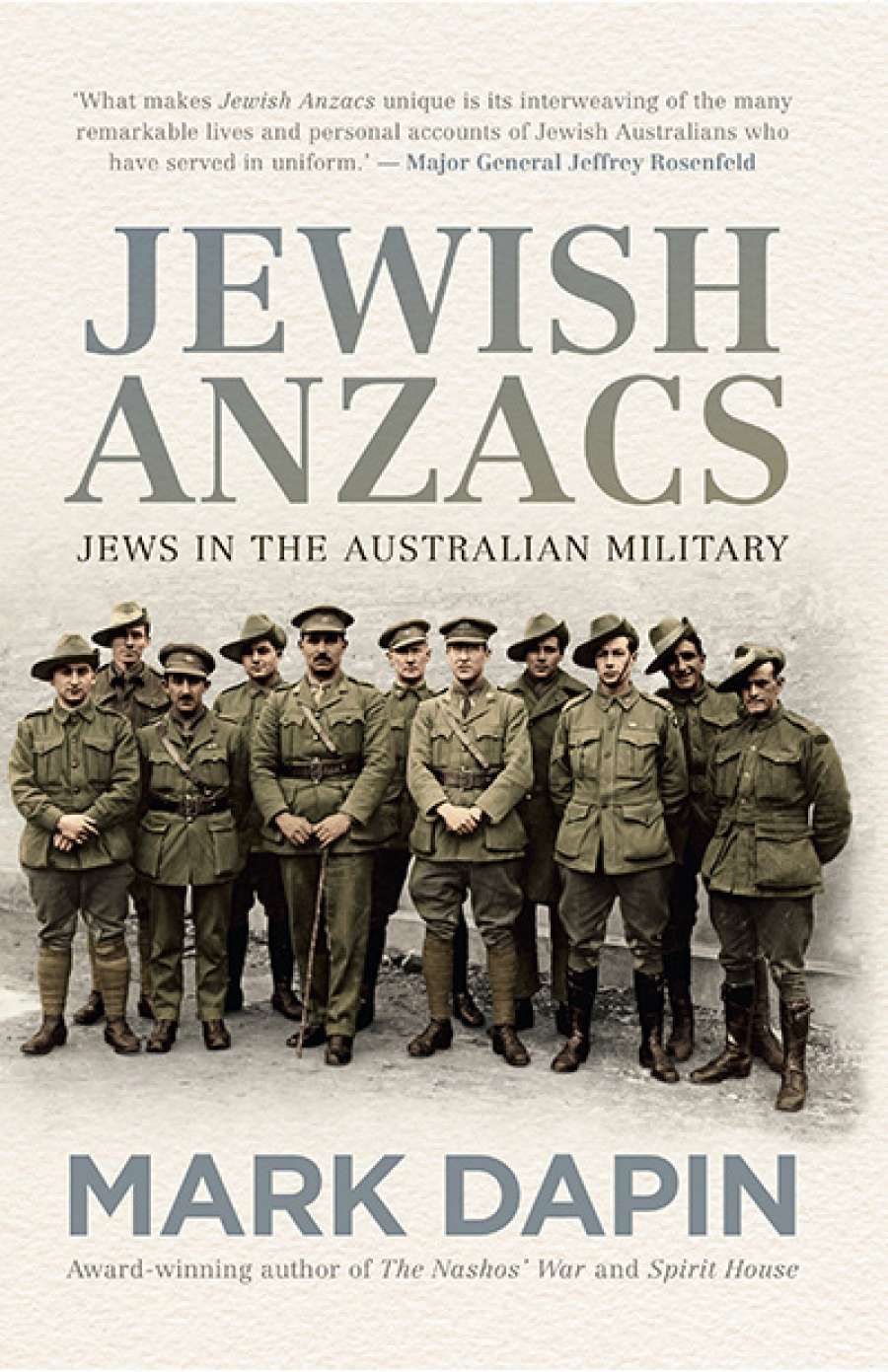
- Free Article: No
- Contents Category: Jewish Studies
- Custom Article Title: Elisabeth Holdsworth reviews 'Jewish Anzacs: Jews in the Australian military' by Mark Dapin
- Review Article: Yes
- Online Only: No
- Book 1 Title: Jewish Anzacs
- Book 1 Subtitle: Jews in the Australian military
- Book 1 Biblio: NewSouth, $39.99 hb, 452 pp, 9781742235356
By the time the British Army left Australia in 1870 there were volunteer militias and Rifle Clubs in every town and city. For an emerging Jewish middle and moneyed class, the militias were a way of advancing socially and of displaying a heartfelt patriotism toward a country that had allowed Jews to flourish. In subsequent decades, campaigns in the Sudan and the Boer Wars established a precedent whereby influential rabbis declared their fervour for these engagements from the bimah, wealthy men paid for arms and strong men served.
And women! Rose Shappere, the first Jewish woman in Victoria to qualify as a nurse, barely survived the infamous siege of Ladysmith (1899–1900). She later gave an excoriating interview to a British newspaper: ‘I never really know how we nurses ever managed to come out of the siege alive ... the military hospital camp was mismanaged. Everything was to our disadvantage ... Everything seemed to go wrong.’ Shappere was mentioned in despatches.
Although active in both the militias and rifle clubs, John Monash did not go to South Africa. A charismatic, driven man with qualifications in civil engineering and law, Monash designed his own gun to replace antiquated musketry. He wore his Jewish/German ancestry with ease and sophistication as he advanced in business and soldiering. Prior to the outbreak of World War I, Monash commanded the Victorian section of the Australian Intelligence Corps as a lieutenant-colonel (1908). He left for the war as a full colonel in command of the Fourth Infantry Brigade as a self-described ‘Australian soldier, citizen and Jew’.
 Lieutenant General John Monash (seated) with his nephews and aides-de-camp Captain Aubrey Moss (left) and Captain Paul Simsonson (right), and Major Walter Berry (centre) of the Australian Corps Headquarters and Chateau Bertangles in the Somme, 20 July 1918Monash bestrides Australia’s military history like a colossus, a logistics genius who regarded soldiering as a science. His British masters at Gallipoli had a fatally different view. Although the final evacuation from the Peninsula came to be regarded as a brilliant feat, the final toll for the AIF was 8,141 dead and 20,000 wounded. Among the dead were thirty-six Jewish Anzacs.
Lieutenant General John Monash (seated) with his nephews and aides-de-camp Captain Aubrey Moss (left) and Captain Paul Simsonson (right), and Major Walter Berry (centre) of the Australian Corps Headquarters and Chateau Bertangles in the Somme, 20 July 1918Monash bestrides Australia’s military history like a colossus, a logistics genius who regarded soldiering as a science. His British masters at Gallipoli had a fatally different view. Although the final evacuation from the Peninsula came to be regarded as a brilliant feat, the final toll for the AIF was 8,141 dead and 20,000 wounded. Among the dead were thirty-six Jewish Anzacs.
Elsewhere in the Middle East, Jewish soldiers were able to reconnect with the biblical past in actions in Palestine. Louis Salek, a Jewish New Zealander, had the honour of hoisting a Magen David, the Zionist flag, at Jerusalem, the first time that potent symbol had ever flown there.
Promoted to brigadier at Gallipoli and then major general on the Western Front, Monash won enormous respect from the British High Command, who wanted him to command a single Australian Army Corps. C.E.W. Bean railed against Monash and his ‘Jewish capacity for worming silently into favour without seeing to take any steps toward it’. Monash exulted that a native-born Australian had achieved the nation’s ambition of having its own commander-in-chief. George V knighted Monash on the battlefield, the first such honour to be granted by a British monarch for two hundred years.
 Sidney Diamond of the 6th Battalion on furlough at Giza, EgyptA generation later, Australia’s military was involved in fronts all over the world. Winston Churchill called the fall of Singapore the worst disaster of British military history. Fifteen thousand Australians were captured and sent to places such as Changi and the Burma railway. Maurice Ashkanasy, assistant general for the AIF in Malaya, did not fancy surrendering to the Japanese. With a party of English soldiers, he stole a lifeboat and, after many adventures, made it to Sumatra where they met an assistant Dutch commissioner. Ashkanasy made an agreement on behalf of King George with Queen Wilhelmina to sell the lifeboat to the Dutch navy in exchange for towage up the river. Our hero made it to Fremantle, as did the Indonesian Dutch government in exile.
Sidney Diamond of the 6th Battalion on furlough at Giza, EgyptA generation later, Australia’s military was involved in fronts all over the world. Winston Churchill called the fall of Singapore the worst disaster of British military history. Fifteen thousand Australians were captured and sent to places such as Changi and the Burma railway. Maurice Ashkanasy, assistant general for the AIF in Malaya, did not fancy surrendering to the Japanese. With a party of English soldiers, he stole a lifeboat and, after many adventures, made it to Sumatra where they met an assistant Dutch commissioner. Ashkanasy made an agreement on behalf of King George with Queen Wilhelmina to sell the lifeboat to the Dutch navy in exchange for towage up the river. Our hero made it to Fremantle, as did the Indonesian Dutch government in exile.
To date, some 7,000 Jews have served in Australia’s military, of whom 340 have lost their lives. Mark Dapin has done them justice.


Comments powered by CComment